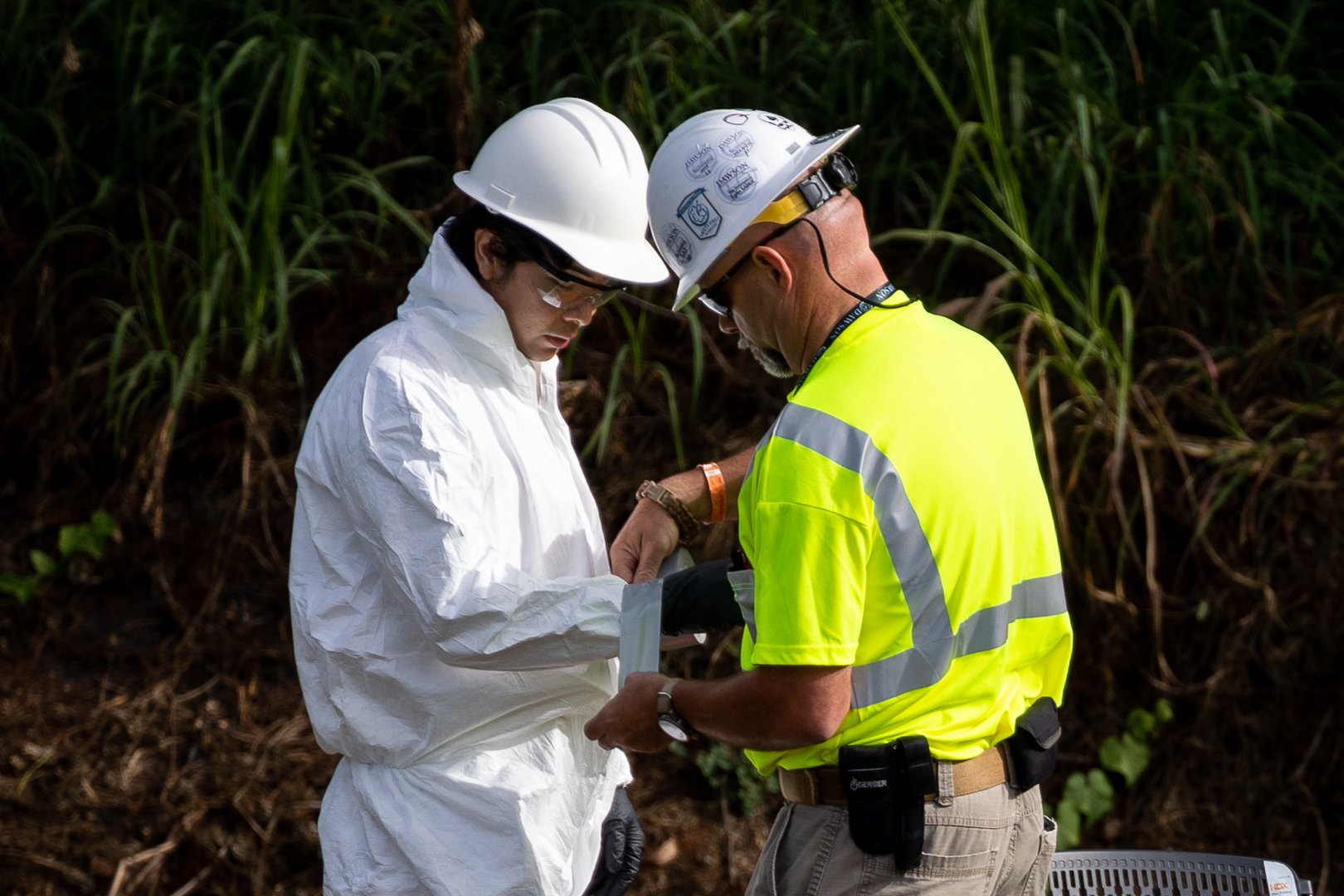How Hoʻōla Maui crews inspect for asbestos
An important part of the U.S. Army Corps of Engineers’ current Hazard Site Assessment work underway by Hoʻōla Maui member DAWSON is inspecting properties for hazardous materials. Asbestos is one of those hazardous materials that can have serious negative health impacts, which is why it’s important to test for it and dispose of it as safely as possible.
Let’s take a deep dive into asbestos to understand how Hoʻōla Maui crews under DAWSON’s leadership test for and handle this hazardous material in the fields to minimize harm to themselves and the community.
So, what is asbestos?
Asbestos is a naturally occurring mineral found in rock and soil. It is made up of small fibers that look like fishhooks or barbs when viewed under a microscope. These strong fibers made asbestos an appealing product to use in construction and building materials throughout the mid-1900s, but its use declined in the 1970s when its negative health effects became more widely known. Asbestos can be found in materials like insulation, cement and adhesives.
If inhaled, it can be hazardous and create chronic health conditions including asbestosis (which is similar to chronic obstructive pulmonary disease [COPD]), mesothelioma and lung cancer. That’s why it is extremely important to inspect and test for asbestos during the cleanup process, so overall negative impacts to human health are minimized.
What safety precautions need to be taken for asbestos?
When inside the ash footprint, inspectors suit up in Level-C personal protective gear, which includes a full-body Tyvek suit, a half-face respirator, and disposable boot covers. For the community and residents entering the ash footprint, it’s safest to assume that there is asbestos present on your property, so wear a Tyvek suit, disposable boot covers, and a properly fitted N-95face mask or respirator to protect yourself.
DAWSON crew members in the field help each other suit up in Level-C personal protective gear.
How are Hoʻōla Maui crews looking for asbestos in Lahaina?
Certified Asbestos Consultants (CAC) with Environmental Risk Analysis are leading Hoʻōla Maui’s efforts on the ground to inspect for asbestos. At this stage of the site assessments, inspectors are looking for material that is likely to be contaminated with asbestos based on the age of the structure. The goal is to identify and remove bulk asbestos materials that may pose a health hazard during the Phase 2 debris removal process.
If an inspector believes there is asbestos present on a property, a small sample is taken and sent to a lab to run a polarized light microscopy (PLM) test. If the test indicates the sample contains less than 1% of asbestos, it can be treated as debris under federal safety standards. If it contains more than 1% of asbestos, it is considered contaminated debris and must be collected following specific safety regulations and disposal compliance standards per the Toxic Substances Control Act (TSCA).
What safety regulations and compliance standards are being followed during the inspection process?
For the site assessments and inspections, all inspectors follow National Emission Standards for Hazardous Air Pollutants (NESHAP) regulations, which are overseen by the U.S. Environmental Protection Agency (EPA). Inspectors also follow Occupational Safety and Health Administration (OSHA) regulations.
Where is asbestos being found on properties in Lahaina?
So far, inspectors have found asbestos in less than 10% of properties in Lahaina. Inspectors are finding asbestos most often on the undercoating of sinks and in an adhesive material called mastic which is being found under tiles.
It’s important to keep in mind that the presence of asbestos is likely much higher in the ash in Lahaina. This is because the extremely devastating nature of the wildfires burned materials like property foundations and concrete walls to ash, and these are materials that commonly contain asbestos.
DAWSON crew collect samples of suspected asbestos-contaminated materials to be tested in the lab.
How will asbestos-contaminated debris be treated and disposed of?
Debris contaminated with asbestos gets treated in different ways depending on its size. Contaminated ash and bulk material will be sprayed down with water so the asbestos fibers can’t fly into the air. Then it will be double bagged in a six-millimeter poly bag and clearly labeled as an asbestos danger, along with the property Tax Map Key (TMK) where it was removed. If the bulk material is too big for a poly bag, debris removal crews will “burrito wrap” it in tarp and label it.
If asbestos is stuck to a structure on the property that is too large to be bagged or burrito wrapped, inspectors mark it with pink paint and notify debris removal contractors that the material cannot be recycled.
Do you have questions about asbestos inspections on properties affected by the Maui wildfires? Contact us to get in touch with our subject matter experts.


